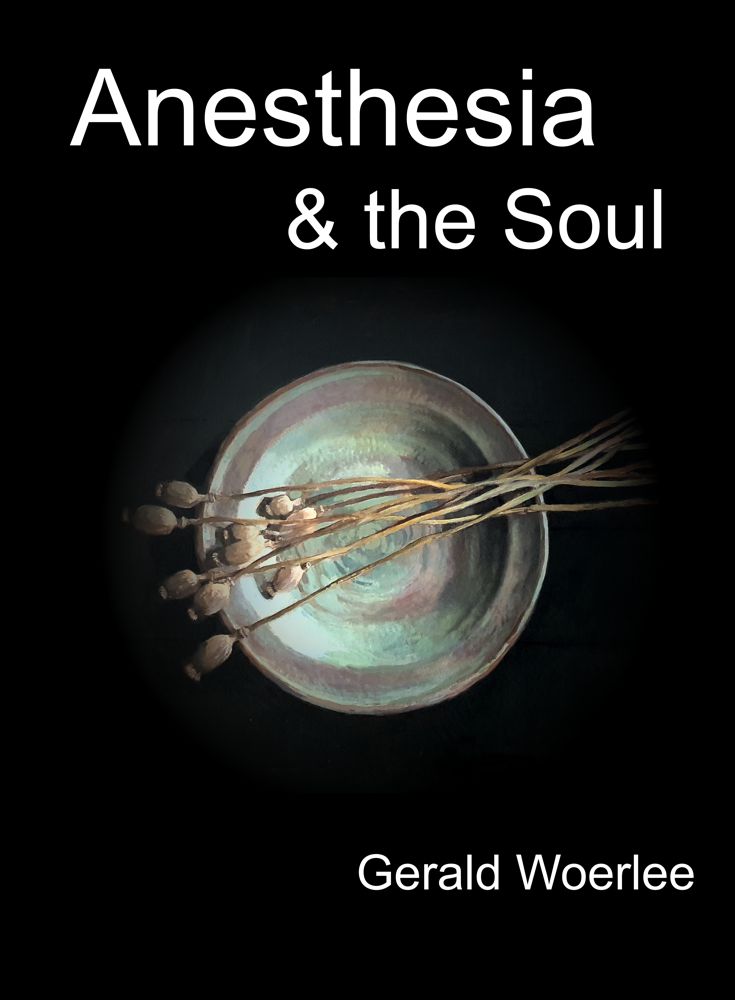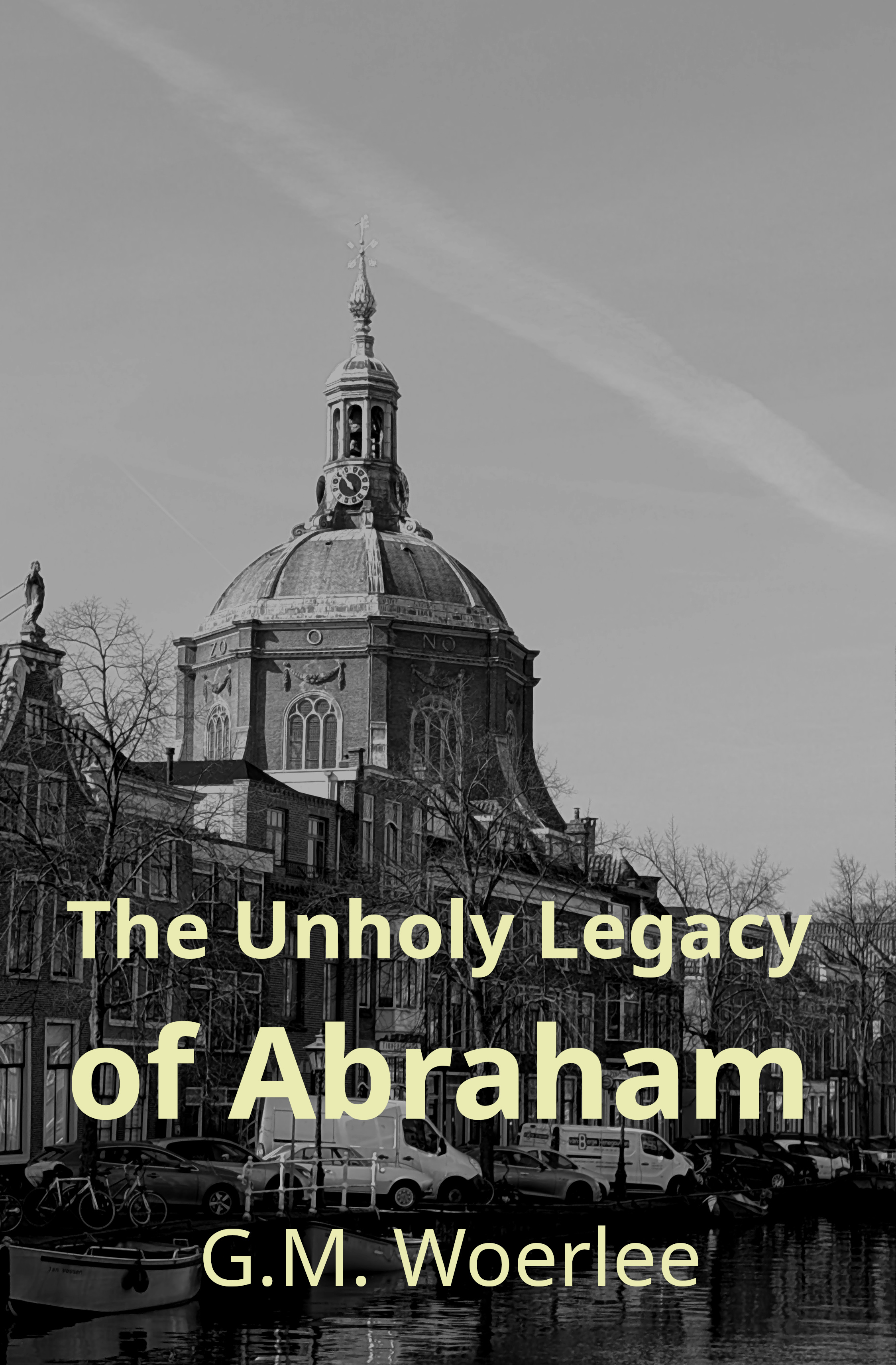Memory and the Soul
©G.M. Woerlee, 2005–2025
Many people, and many religions propose and believe that the soul, or separable human consciousness, is the actual conscious mind of the body, controlling the body to speak and act, as well as being the indelible repository of all memories of the human body. Proof for this belief is ostensibly revealed by religions stating that souls of the deceased retain all memories of their lives and thoughts while mortal, as well as reports of “Life Review” and veridical observations made during near death experiences, and out-of-body experiences undergone during cardiac arrest when there was no apparent brain activity, or memories reported by persons subsequent to near-death experiences due to many other causes.
Indeed, many, many anecdotal, and some veridical accounts of near-death experiences and out-of-body experiences provide just such apparent proof of the retention of memories in the soul, or some sort of immaterial and separable human consciousness (Carter 2010, Lommel 2010, Long 2010, Moody 1976, Wade 1998, and many others). Consider the example of the experience of a young man who underwent an out-of-body experience caused by an automobile accident.
This superficially simple account reveals profound insights into the memory functions of the human soul, or separable human consciousness. For clarity, I will examine these in a point-by-point fashion.
- The above short account refers to several factual and spatial memories such as estimation of distances, recognition of a car, and recognition of up and down. This is clear evidence of recognition based upon long-term memories of experiences and facts learned by his physically conscious body long before the accident. However, his mind was apparently separated from his body at the time he recognized these things, so these memories were evidently recalled from within his disembodied mind.
- His apparently disembodied mind recognized the appearance of his body, and the appearance of his friend. This is also clear evidence of recognition based upon long-term memories of his, and his friend’s appearances learned during physical consciousness and retained within his now disembodied soul.
- His account tells of remembering the last echoes of the car crash, the situation of his body, observing people running to help, as well as all the above things. This indicates transformation of temporarily retained perceptions, observations and experiences, otherwise known as short-term memories, into permanently retained long-term memories. Furthermore, these events occurred during a period of apparent disembodiment of his conscious mind from his physical body, indicating that transformation of short-term memories into long-term memories occurred within his apparently disembodied conscious mind, or soul.
This man was only able to report this account to other people after recovering physical consciousness and the ability to speak. He reported this account to others with the mechanisms of his physical body, such as speech and possibly writing. Moreover, he reported this account sometime after his out-of-body experience, and certainly not during his out-of-body experience. This last fact means his report is the account of a memory of his out-of-body experience subsequently reported through the mechanisms of his physical body. Furthermore, he spontaneously recalled and reported these memories without the application of coercion, drugs, torture, hypnosis, or psychological techniques to extract these memories. This account contained old past memories, as well as new memories formed during a period of ostensible disembodiment of his conscious mind. So this experience seemingly indicates that the soul is the repository of all memories, as well as the location where short-term memories are transformed into long-term memories.
But periods of disembodiment are not restricted to the proximity of the physical body. During near-death experiences, the apparently disembodied conscious minds of some people are apparently transported, or translocate to an immaterial afterlife universe inhabited by the souls of the dead. Accounts of such near-death experiences reveal that apparently disembodied souls can access previous memories when transported to this transcendental afterlife universe. Such accounts also reveal that when the apparently disembodied soul is present in this afterlife universe, it is capable of forming new long-term memories (Chapters 5 and 6 in Carter 2010, Wade 1998). Consider this memory of a visit to the Christian transcendental afterlife universe undergone by a man during a near-death experience caused by a cardiac arrest.
This short account reveals all the above points. During the period the disembodied soul of this man was present in this transcendental world, his disembodied soul recognized his parents, remembered the fact his mother was an amputee, remembered the miraculous restoration of her amputated leg, as well as remembering the details of the transcendental world they now inhabited. Subsequent to his physical body recovering from the bodily effects of the cardiac arrest, he was able to spontaneously recall and relate these new memories that were formed and retained within his apparently disembodied soul through the mechanisms of his physical body to other physical people.
People never relate what they are undergoing to other people during periods of disembodiment occurring during near death experiences or out-of-body experiences. Only after the physical bodies of these people arouse from the causes of their near-death, or out-of-body experiences, are they physically able to communicate their memories of these experiences to other equally physically conscious people using the mechanisms of their physical bodies. We have no other source of knowledge of these experiences — accounts of disembodiment during near death experiences, or out-of-body experiences are always remembered experiences recalled after return to normal physical consciousness. Memories of these experiences are spontaneously recalled memories. They are not memories revealed by word association tests, drugs, hypnosis, stimulation of the brain with electrical currents, or torture. Such spontaneously recalled memories require adequate functioning of those mechanisms of the brain and body through which these memories are recalled to be subsequently revealed in speech or in writing. During periods of disembodiment occurring during “clinical death” due to cardiac arrest, the physical body is incapable of perceiving anything, because the body and the brain supposedly no longer function according to many near death experience researchers (Greyson 2003, page 228 in Holden 2009, Lommel 2001, page 167 in Lommel 2010, Parnia 2007). According to these researchers, all memories of experiences undergone during disembodiment during cardiac arrest are located within the separable immaterial consciousness — subsequently, interaction of this separable consciousness with the mechanisms of the body is essential to reveal any recall of these memories to other physically conscious persons. Memory is therefore an essential part of the mental activity of the soul. Indeed, memory is one of the most important fundamental properties of the soul, or the immaterial and separable human consciousness proposed by many believers in the immaterial reality of the near death experience and the out-of-body experience.
Memories in Brain, or in Soul?
Fortunately, the location of memories, whether in some immaterial and separable human consciousness, human soul, or within the physical human brain is very amenable to testing in this physical world. [For brevity I will use the old-fashioned term, the “soul” instead of separable immaterial human consciousness]. There are two ways of looking at the location of memory.
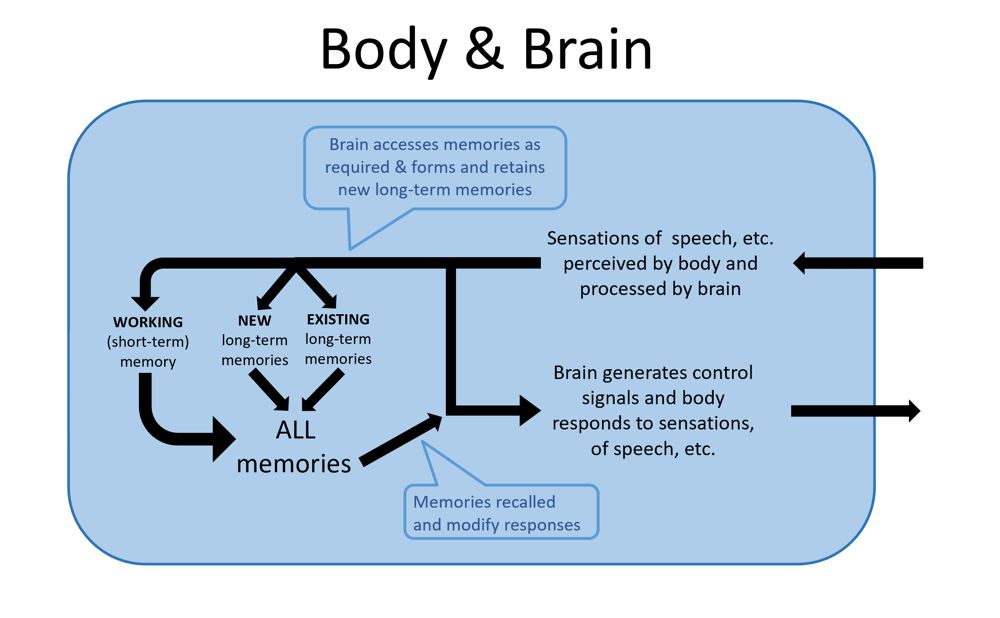
One system of thought says that the physical brain is the repository and retrieval center for all memories, and the controller of the thoughts, speech, actions and deeds of the physical body.
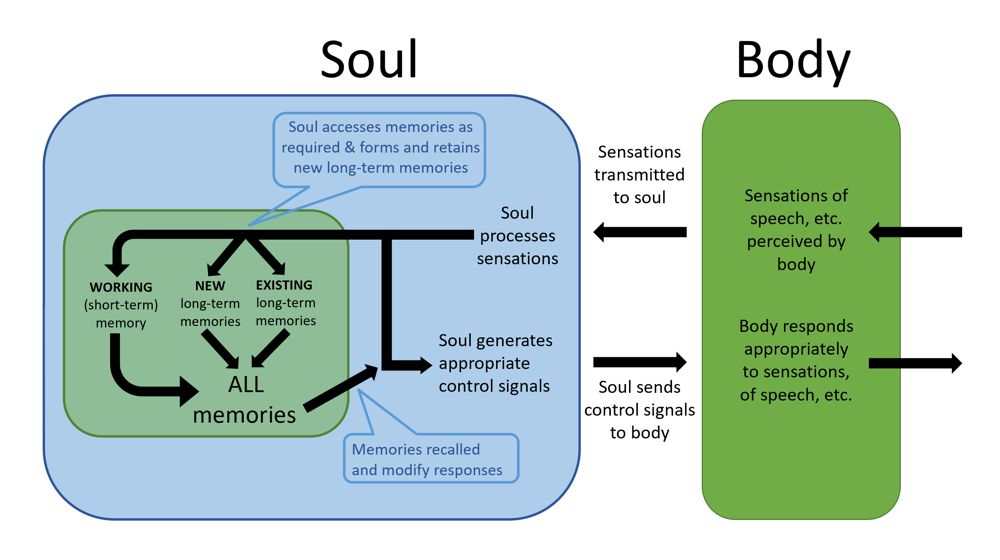
Another system of thought says that a separable immaterial consciousness, or soul is the repository and retrieval center for all memories, and the controller of all thoughts, speech, actions and deeds of the physical body. Some unknown form of coupling must exist between the physical body and soul, or separable human consciousness if this system of thought is true.
Regardless of which system of thought is true, the results are the same. All memories communicated from one person to another are communicated through the medium of actions, speech, or writing by the physical body. This brings us to the amazing effects of the drug Midazolam that enables us to differentiate between these two systems of thought.
Midazolam and memory
The sedative drug Midazolam has been used to provide “conscious sedation” during medical procedures for more than twenty years and consistently blocks memory formation of events occurring during sedation. This effect of Midazolam on longer term memory formation makes it possible to differentiate whether the location of memories is within the physical brain, or extracorporeal within the soul or separable immaterial consciousness. So what do physicians the world over observe during conscious sedation? This is extensively discussed in Chapter 7 of “Anesthesia & the Soul” (Woerlee 2020).
- Midazolam administered at doses sufficient to cause amnesia does not induce loss of consciousness. After such doses of midazolam, most people are somewhat sedated, yet perceive and react appropriately to their surroundings. They are cooperative, talk normally, answer questions appropriately, can remember past events, and otherwise react appropriately with speech and movements.
- According to believers in the reality of the human soul, the physical body supposedly transmits perceptions of speech, sight, touch, and surroundings in some way to the soul, which then controls the body to speak, move, and act appropriately in response to others and the situation. Furthermore, perceptions made by the physical body of speech, sounds, sights, etc are transmitted to the soul and stored as long term memories.
- The human soul is believed by some to be the indelible repository of all memories.
- The human soul is supposedly unaffected by drugs affecting the physical brain, which means that the memory functions of the human soul are also unaffected by midazolam.
- Therefore, according to believers in the reality of the human soul, the souls of persons undergoing conscious sedation with midazolam should form long-term memories of their thoughts, as well as their perceptions, speech, actions, and deeds while sedated.
- All physical brain functions return to normal after the body eliminates all the administered midazolam. This means that all brain functions needed to retrieve memories from the soul also return to normal once the drug is eliminated from the body. The person now recovered from sedation should be able to remember all events, speech, and memories recalled during the period of sedation. After all, the memories recalled by the person during sedation, and their responses to speech all passed through, were fetched from memory repositories within their souls, and were controlled by their souls.
- But something totally contrary to what the human soul mind-model propounds is observed — most people CANNOT RECALL any of their thoughts, speech, or actions during the period of conscious sedation.
This observation is repeated many, many millions of times each year, all over the world wherever midazolam is employed for both its conscious sedation and amnesic effects. It is the daily reality and observation of all physicians and other personnel administering midazolam for conscious sedation.
Explanation — brain is respository of memories
The soul, or separable immaterial consciousness, is unaffected by the drug midazolam, and so should also form memories of all events, speech, and movements occurring during conscious sedation. But this does not occur… So let us examine where midazolam acts as demonstrated by the effects of midazolam. To begin with — the body and soul model, where memory and control of the body are performed by the soul.
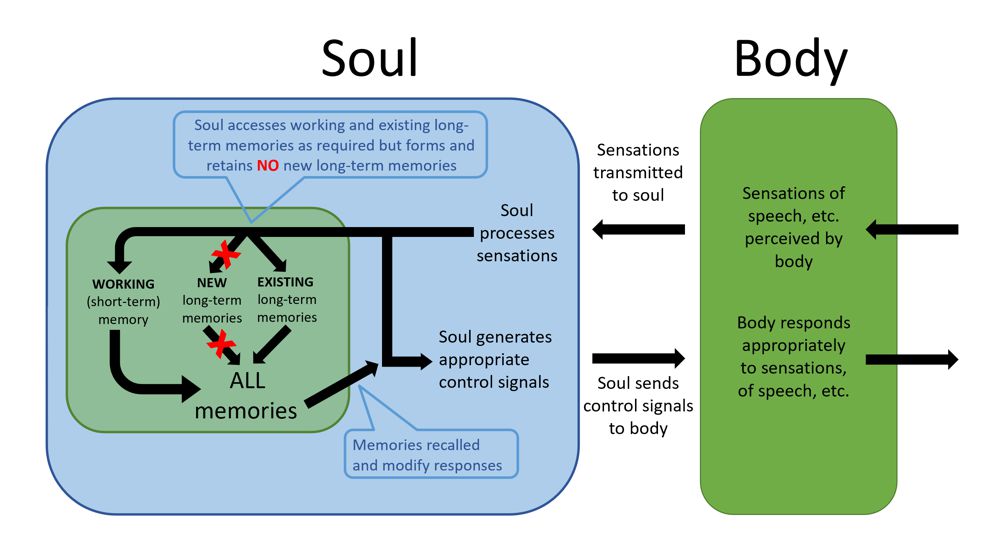
The diagram above is of the model of a body controlled by a soul or immaterial separable consciousness. All people believing in the reality of a soul or separable immaterial consciousness, claim that the soul is unaffected by things affecting the physical brain. During conscious sedation, sensations of speech as conversation and requests are transmitted normally from the body to the controlling separable consciousness, or soul — this must be true, because the sedated person responds with the appropriate answers during conversations, and can recall long-term memories. Accordingly, if all memories are stored within the soul, these conversations, requests, observations, and all other experiences undergone during conscious sedation should be stored within the memory of the separable consciousness, or soul. Yet subsequent to recovering from conscious sedation, most people have absolutely no memory of anything occurring while sedated with midazolam. The consequence is clear, midazolam must act within the soul, or separable immaterial consciousness to block long term memory formation. But any action of midazolam within the soul is impossible, because the soul, or separable immaterial consciousness is unaffected by things affecting the body… . Blockade of long term memory formation elsewhere in the body, or the soul, does not correspond with decades of observation of millions of persons administered this drug. Therefore this model fails to describe the reality of decades of observation of the effects of midazolam, which means that memories are not stored within the soul, or some separable immaterial consciousness.
This brings us to the model where the brain is the repository of all memories, and controller of the body.
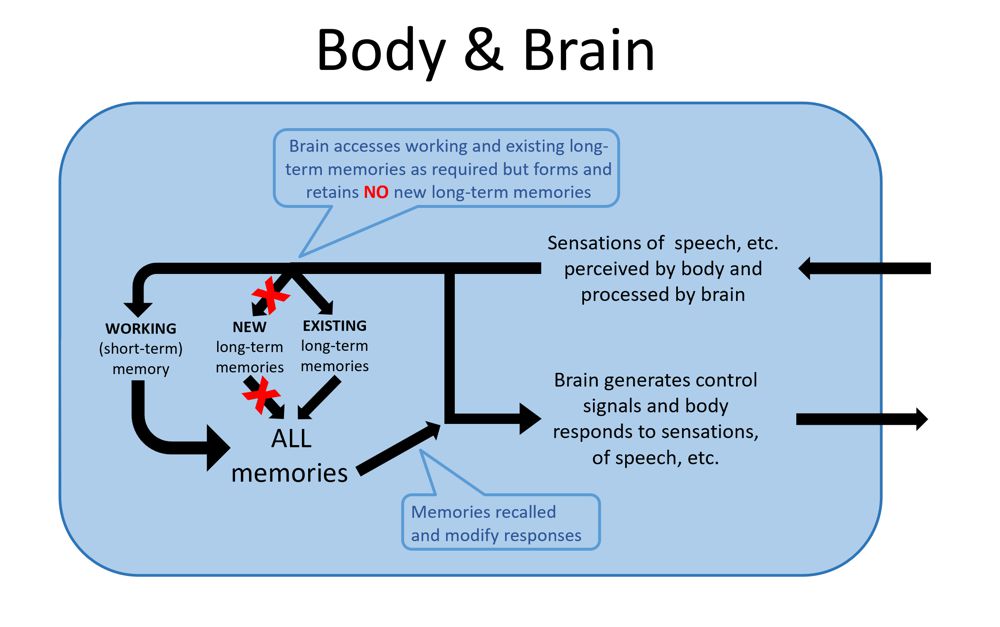
The brain as repository of all memories and controller of the body. The effect of sedative doses of midazolam does not affect transmission of external signals such as speech movement and sensation. The brain is still able to process and act on these signals. However, the low concentrations of midazolam causing conscious sedation, while insufficient to block recall of existing long term memories, are sufficient to block formation of new long term memories, because of action on more sensitive parts of the brain. This explains all aspects of the effects of conscious sedation on memory function — memories are stored within the physical brain.
Objections to this logic
Upon hearing this, some believers in the reality of a human soul might exclaim, “Conscious sedation means that some regions of the physical brain are affected, otherwise no sedation would be present. This could possibly affect the signals transmitted from the body to the soul, and explain why the soul receives no signals indicating that it should retain memories of events and speech perceived during conscious sedation … ”. Unfortunately such an explanation clearly implies that the brain is necessary to initiate memory formation and retention, meaning that the brain is necessary. Furthermore, it also implies the brain is selective in what is stored in long term memory, while religions imply that the soul remembers everything, every smallest detail. The same is also true of believers in the reality of the near death experience, who claim that “Life Review”also revives all memories, every smallest detail.
Conclusion
Only one conclusion is possible — memory formation and retention is a function of the brain and not of an immaterial soul. Absence of memory formation and retention by the soul has far-reaching implications as explained in Chapters 7 and 16 in “Anesthesia & the Soul” (Woerlee 2020).
- A soul without the ability to form memories cannot recall what it experiences during periods of disembodiment. Accordingly, accounts of apparent disembodiment during near death experiences and out-of-body experiences are memories of perceptions made during hallucinations of disembodiment occurring within the physical brains of people subsequently reporting such experiences.
- Christianity and Islam propose a system of eternal punishment or reward in everlasting afterlife inhabited by the souls of the dead. However, absence of memory function in a separable immaterial conscious mind means that everlasting punishment or reward of the immaterial soul has no function. Without memory, punishment or reward are visited upon a conscious mind with no memories of anything. It would serve no real purpose—it would not even be punishment or reward—a soul without memory would just undergo these things without knowing or understanding. A soul without memory can experience no heaven, nor can it experience hell—heaven and hell simply do not exist for a soul without memory.
- Hinduism and Buddhism are two religions proposing reincarnation of the soul, but absence of memory in the soul means that the reincarnated soul learns nothing during each reincarnation. The reality of absent memory function in the human soul demolishes this fundamental postulate of reincarnation.
Absence of memory function in the soul means that an immaterial human soul with the properties propounded by believers for more than 4,500 years simply does not exist. Accordingly, the human soul, if it exists, has properties very, very different to those believed by most proponents of the reality of a human soul, or separable immaterial consciousness. This is all extensively discussed in the free ebook, “Anesthesia & the Soul” (Woerlee 2020), which reveals how common observations in anesthesia and normal life reveal that memory is located withing the physical brain, and not within an immaterial soul, or separable human consciousness.
Memory and other topics are extensively discussed in the ebooks “Anesthesia & the Soul” and “The Unholy Legacy of Abraham”. Readers can download these ebooks for free by clicking the relevant button.
References.
- Carter CD, (2010), Science and the Near-Death Experience: How Consciousness Survives Death. Published by Inner Traditions, Vermont, USA, ISBN 978-1-59477-356-3.
- Greyson B, (2003), Incidence and correlates of near-death experiences in a cardiac care unit. General Hospital Psychiatry, 25: 269-276.
- Holden JM, Greyson B, and James D, (Eds.) (2009), The Handbook of Near-Death Experiences: Thirty Years of Investigation, Published by Praeger/ABC-CLIO, Santa Barbara, California, USA, ISBN 978-0-313-35864-7.
- Lommel P van, et al, (2001), Near-death experience in survivors of cardiac arrest: a prospective study in the Netherlands. Lancet, 358: 2039-2045.
- Lommel P van, (2010), Consciousness Beyond Life: The Science of the Near-Death Experience. Published by HarperCollins, USA, ISBN 9780061777257.
- Long J, Perry P, (2010), Evidence of the Afterlife. The Science of Near-Death Experiences. Published by HarperOne, USA, ISBN 978-0-06-145255-0.
- Moody RA, (1976), Life after Life, published Bantam, U.S.A., ISBN 0-553-27484-8.
- Parnia S, (2007), Do reports of consciousness during cardiac arrest hold the key to discovering the nature of consciousness? Medical Hypotheses, 69: 933-937.
- Rawlings M, (1979), Beyond Death’s Door. Published by Bantam Books, New York, ISBN 0553229702.
- Wade J, (1998), Physically transcendent awareness: a comparison of the phenomenology of consciousness before birth and after death. Journal of Near-Death Studies, 16: 249-275.
- Woerlee GM, (2020), Anesthesia & the Soul Download E-Book in pdf format
